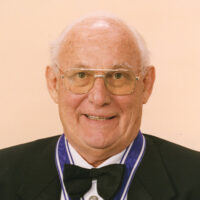
1999 Kyoto Prize Laureates
Materials Science and Engineering
/ Ceramic Material Scientist
1926 - 2000
Regents Professor, The University of Arizona
The Science and Technology of Made Things
1999
11 /11 Thu
Place:Kyoto International Conference Center
Development and Applications of Ceramic Science
1999
11 /12 Fri
13:00 - 17:30
Place:Kyoto International Conference Center
Dr. Kingery has made a fundamental contribution to the establishment of ceramic technology as a part of materials science and engineering, by theoretically systematizing the technology, including his own research results, that conventionally had relied solely on empirical rules. He thus contributed greatly to the development of this field today.
Dr. Kingery introduced a chemical and physical approach to ceramics, a field which had previously relied on empirical rules and an outdated scientific treatment, creating the discipline of “physical ceramics.” He was therefore a driving force behind the establishment of ceramics as a materials science, contributing enormously to the development of this field.
Dr. Kingery engaged in systematic research on sintering, the most basic process in ceramic manufacturing. His analysis of the sintering velocity of various models demonstrated that the sintering mechanism can be identified with mechanisms such as viscous flow, vaporization and condensation, and internal diffusion. In particular, he explained that liquid phase sintering, the most important process in ceramic manufacturing, proceeds in three stages-the wetting of particles through liquefaction, particle rearrangement, and dissolution and precipitation-providing the first theoretical elucidation of the essence of this process. Through this line of research, he also revealed that the key factor controlling the sintering mechanism of ceramics and the microstructures and physical properties of sintered materials is the diffusion coefficient of the component ions. Further, through his observation that the elimination of the pores, the final stage of sintering, proceeded through an interaction between pores and grain boundaries, Dr. Kingery provided the guidelines for an integrated understanding of the sintering process as a whole, from the initial to the final stage. The theories above have become basic guidelines for today’s ceramic manufacturing.
In his research on ionic conduction, Dr. Kingery measured the diffusion coefficient of oxygen ions in oxides, elucidating the behavior of oxygen ions and lattice defects and making an important contribution to analysis of the diffusion phenomenon. He also proposed new concepts based on his insights into the properties of the grain boundaries of ionic crystals, laying the groundwork for the development of more diversified ceramics applications. The results of his research in ceramic materials science have been applied to a number of ceramic manufacturing processes, including electronic ceramics, engineering ceramics and structural ceramics, leading to the production of an array of important industrial products.
Dr. Kingery presented the results of his work to the world in his Introduction to Ceramics. Still known today as the bible of ceramic materials science, this publication epitomizes Dr. Kingery’s contribution to materials science and demonstrates why he is called the “father of modern ceramics.”
As seen above, Dr. Kingery has made outstanding achievements in systematizing the discipline of ceramics as a science and has led the development of ceramic materials science worldwide through his many publications and the guidance provided by his research. For these reasons, the Inamori Foundation is pleased to bestow upon Dr. Kingery the 1999 Kyoto Prize in Advanced Technology.
Profile is at the time of the award.